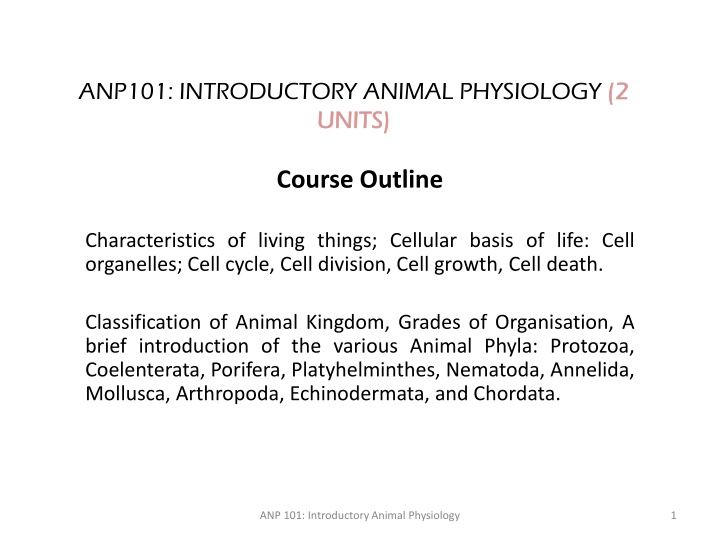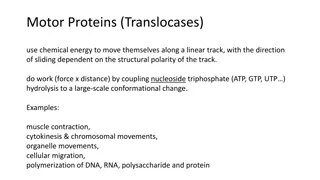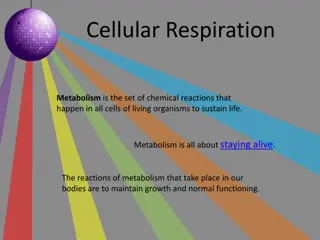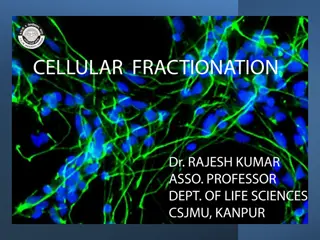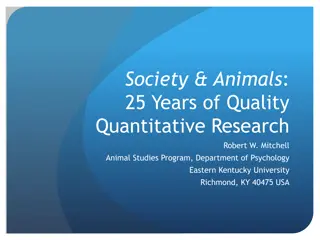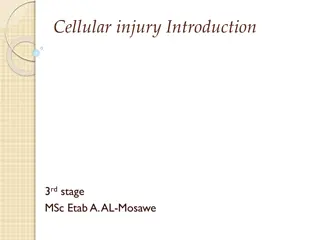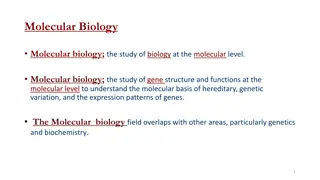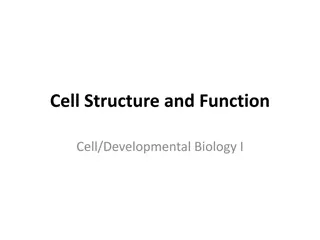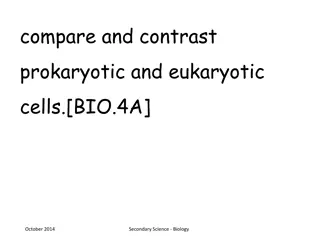Introduction to Animal Physiology and Cellular Biology Overview
This comprehensive course delves into the fundamental aspects of animal physiology and cellular biology. Topics covered include the characteristics of living organisms, cellular organelles, the cell cycle, division, growth, and death. Additionally, the course introduces the various animal phyla, from Protozoa to Chordata, and discusses the distinctions between prokaryotic and eukaryotic cells, highlighting their structures and functions.
Download Presentation

Please find below an Image/Link to download the presentation.
The content on the website is provided AS IS for your information and personal use only. It may not be sold, licensed, or shared on other websites without obtaining consent from the author.If you encounter any issues during the download, it is possible that the publisher has removed the file from their server.
You are allowed to download the files provided on this website for personal or commercial use, subject to the condition that they are used lawfully. All files are the property of their respective owners.
The content on the website is provided AS IS for your information and personal use only. It may not be sold, licensed, or shared on other websites without obtaining consent from the author.
E N D
Presentation Transcript
ANP101: INTRODUCTORY ANIMAL PHYSIOLOGY (2 UNITS) UNITS) (2 Course Outline Characteristics of living things; Cellular basis of life: Cell organelles; Cell cycle, Cell division, Cell growth, Cell death. Classification of Animal Kingdom, Grades of Organisation, A brief introduction of the various Animal Phyla: Protozoa, Coelenterata, Porifera, Platyhelminthes, Nematoda, Annelida, Mollusca, Arthropoda, Echinodermata, and Chordata. ANP 101: Introductory Animal Physiology 1
Definition of Biology Biology is the science that is focussed on the study of living things. The major branches of biology are: Anatomy, which deals with gross structure Physiology, which is the study of gross function or how the organism works Histology, the study of tissues Cell biology, the study of cells Microbiology, concerned with the study of fungi (mycology), bacteria (bacteriology) and viruses (virology) Biochemistry and Molecular Biology, study of living systems at the molecular level Genetics, study of inheritance Zoology, study of animals Botany, study of plants ANP 101: Introductory Animal Physiology 2
Prokaryotes and Eukaryotes 2 general categories of cells: Prokaryotes Organisms that lack a nuclear membrane, e.g. Bacteria Unicellular organisms, never differentiate into multi-cellular forms Lack cell organelles; plasma membrane performs most of the functions of cell organelles. Consist of 3 parts: Flagella and pili which are proteins attached to the cell surface Cell envelope consisting of a cell wall, a plasma membrane, and Cytoplasmic region containing the cell genome (DNA), ribosomes, etc. ANP 101: Introductory Animal Physiology 3
Prokaryotes and Eukaryotes, contd. Eukaryotes Include fungi, animals, plants, and some unicellular organisms; about 10 x the size of prokaryotes and can be up to 1,000 x greater in volume Contain membrane-bound compartments in which specific metabolic activities take place Has a Nucleus a membrane-bound compartment which contains the cell s DNA Have other specialized structures called Organelles: Small structures within cells, performing dedicated functions. ANP 101: Introductory Animal Physiology 5
EXAMPLE OF A EUKARYOTIC CELL ANP 101: Introductory Animal Physiology 6
The Plasma Membrane Outer lining of the cell. Separates and protects the cell from its surrounding environment Made up of a double layer of lipid molecules and protein Embedded proteins act as channels and pumps moving molecules in and out of the cell. A form of plasma membrane found in prokaryotes is usually called the cell membrane. ANP 101: Introductory Animal Physiology 7
The Cytoskeleton Complex and dynamic cell component Acts to organize and maintain the cell s shape Anchors organelles in place Helps during endocytosis the uptake of external materials by a cell Moves parts of the cell in processes of growth and motility A great number of proteins are associated with the cytoskeleton, controlling a cell s structure by directing, bundling and aligning filaments. ANP 101: Introductory Animal Physiology 8
The Cytoplasm Internal, fluid-filled space of the cell Also called The Cytosol In eukaryotes all cell organelles reside in the cytosol It is also home to the cytoskeleton Contains dissolved nutrients Helps to break down waste products Moves materials around the cell through a process known as cytoplasmic streaming Contains many salts and is an excellent conductor of electricity. ANP 101: Introductory Animal Physiology 9
The Nucleus Most conspicuous organelle found in eukaryotic cell Contains the cell s chromosomes Place where almost all DNA replication and RNA synthesis occurs Spheroid in shape and separated from the cytosol by the nuclear membrane Nuclear membrane isolates and protects a cell s DNA from molecules that could accidentally damage its structure or interfere with its processes. DNA is transcribed, forming Messenger RNA (mRNA) mRNA is transported to the cytosol where it is translated into a specific protein molecule In prokaryotes, DNA processing takes place in the cytoplasm. ANP 101: Introductory Animal Physiology 10
The Ribosome Found in both prokaryotes and eukaryotes Composed of large complex molecules, including RNAs and Proteins Responsible for processing genetic instructions carried by a mRNA Process of converting the genetic code carried by a mRNA into the correct sequence of amino acids that make up a protein is called Translation There are usually large numbers of ribosomes in a cell as protein synthesis is extremely important for proper functioning of cells Ribosomes float freely in the cytosol but are sometimes bound to the endoplasmic reticulum Ribosomes comprise of one large and one small subunit, each having a different function during protein synthesis ANP 101: Introductory Animal Physiology 11
Mitochondria Self-replicating organelles found in cytoplasm of all eukaryotic cells Occur in various numbers, shapes and sizes They contain their own genome separate and distinct from the nuclear genome of a cell Have 2 functionally distinct membrane systems separated by a space: Outer membrane which surrounds the whole organelle, and Inner membrane which form folds called Cristae Number and shape of cristae in mitochondria vary with tissue and organism in which they are found ANP 101: Introductory Animal Physiology 12
Glycolysis Play critical role in generating energy in eukaryotic cell; process involves complex pathways Glycolysis (1st pathway) requires no oxygen and is referred to as anaerobic metabolism Occurs in the cytoplasm, outside the mitochondria Glucose is broken down into pyruvate; each reaction produces some hydrogen ions which are then used to make ATP 4 molecules of ATP are made from one molecule of glucose in glycolysis In prokaryotes, glycolysis is the only pathway used for converting energy ANP 101: Introductory Animal Physiology 13
Krebs cycle or Citric acid cycle Kreb s cycle or Citric acid cycle: Occurs inside the mitochondria Capable of generating enough ATP to run all the cell functions Cycle begins with glucose molecule which is stripped of some of its hydrogen atoms to form two molecules of pyruvic acid Next, pyruvic acid is altered by removal of a carbon and 2 oxygen atoms which form CO2 When the CO2 is removed, energy is given off and a molecule of NAD+ is converted into the higher energy form, NADH. Another molecule, coenzyme A, then attaches to the remaining acetyl unit to form acetyl CoA Acetyl CoA joins a 4-carbon molecule (oxaloacetate) to form citric acid, a 6-carbon molecule ANP 101: Introductory Animal Physiology 14
Krebs cycle or Citric acid cycle, contd. Citric acid is broken down and modified in a step-wise fashion, a process leading to the release of hydrogen ions and carbon molecules The carbon molecules are used to make more carbon dioxide The hydrogen ions are picked up by NAD and FAD (flavin-adenine dinucleotide) Eventually oxalate is again produced and the process starts again. Kreb s cycle is capable of generating between 24 and 28 ATP molecules from one glucose molecule converted to pyruvate. ANP 101: Introductory Animal Physiology 15
Chloroplasts and Mitochondria Chloroplasts are similar to mitochondria but are found only in plants Both are surrounded by a double membrane with an inter-membrane space Both have their own DNA Both are involved in energy metabolism Both have reticulations or foldings filling their inner space Chloroplasts convert light energy from the sun into ATP through photosynthesis ANP 101: Introductory Animal Physiology 16
Endoplasmic reticulum and Golgi apparatus Endoplasmic reticulum (ER) the transport network for molecules targeted for certain modifications and specific destinations within the cytoplasm Two forms: Rough ER and Smooth ER. Rough ER has ribosomes adhering to its outer surface Smooth ER has no adhering ribosomes Translation of the mRNA for proteins that will either stay in the ER or exported occurs at the ribosomes attached to the RER. The SER serves as the recipient for proteins synthesized in the RER. Proteins for export are passed to the Golgi body for further processing, packaging and transport to other cellular locations. ANP 101: Introductory Animal Physiology 17
Lysosomes and Peroxisomes Both organelles are spherical, bound by a single membrane and rich in digestive enzymes. Lysosomes contain >36 enzymes for degrading proteins, nucleic acids and polysaccharides. These enzymes are most active at low pH, reducing the risk of autolysis. This shows the importance of compartmentalization in eukaryotic cells. Peroxisomes often resemble a lysosome, but: Peroxisomes are self-replicating while lysosomes are formed in the Golgi complex Peroxisomes also have membrane proteins which are critical for various functions, such as importing proteins into their interiors and to proliferate and segregate into daughter cells. ANP 101: Introductory Animal Physiology 18
What Is pH? The term pH derives from a combination of "p" for the word power and "H" for the symbol of the element hydrogen. pH is the negative log of the activity of hydrogen ions and represents the "activity" of hydrogen ions in a solution at a given temperature. The term activity is used because pH reflects the amount of available hydrogen ions, not the concentration of hydrogen ions. The pH scale for aqueous solutions ranges from 0 to 14 pH units, with pH 7 being neutral. A pH of less than 7 means that the solution is acidic, whereas a pH of more than 7 means that the solution is basic. ANP 101: Introductory Animal Physiology 19
Lysosomes and Peroxisomes, contd. Functions of lysosome: Digests foreign bacteria that invade a cell Helps to recycle receptor proteins and other membrane components Degrades worn out organelles such as mitochondria Can help repair damage to the plasma membrane by serving as a membrane patch, sealing the wound. ANP 101: Introductory Animal Physiology 20
Lysosomes and Peroxisomes, contd. Functions of peroxisome: Rids the body of toxic substances such as hydrogen peroxide or other metabolites Contain enzymes concerned with oxygen utilization Present in high numbers in the liver where toxic byproducts are known to accumulate All enzymes found in a peroxisome are imported from the cytosol Each enzyme transferred to a peroxisome has a special sequence at one end of the protein, called peroxisomal targeting signal (PTS) PTS allows the protein to be taken into that organelle, where they rid the cell of toxic substances. ANP 101: Introductory Animal Physiology 21
THE CELL CYCLE Cell cycle: Sequence of events which occurs between one cell division and the next. It has 3 stages: 1) Interphase period of synthesis and growth Cell produces many materials required for its own growth and for carrying out all its functions DNA replication occurs during this stage 2) Mitosis Process by which the cell nucleus divides to produce 2 daughter nuclei containing identical sets of chromosomes to the parent cell 3) Cell division Process of division of the cytoplasm into 2 daughter cells ANP 101: Introductory Animal Physiology 22
MITOSIS PROPHASE METAPHASE ANAPHASE TELOPHASE G1 + S + G2 = CELLULAR SYNTHESIS G2 CELL DIVISION S M INTERPHASE G1 THE CELL CYCLE CHART ANP 101: Introductory Animal Physiology 23
Key to the Cell Cycle chart Phase Events within cell G1 Intensive cellular synthesis, including cell organelles. Cell metabolic rate high. Cell growth occurs. Substances produced to inhibit or stimulate onset of next phase as appropriate. S DNA replication occurs. Protein molecules called histones are synthesized and cover each DNA strand. Each chromosome becomes two chromatids. At this stage the cell is 4n (4 copies of each DNA molecule, 2 in each homologous chromosome). G2 Intensive cellular synthesis. Mitochondria and chloroplasts divide. Energy stores increase. Mitotic spindle begins to form. M Nuclear division occurs in 4 phases. C Equal distribution of organelles and cytoplasm into each daughter cell. ANP 101: Introductory Animal Physiology 24
MITOSIS Interphase Varies in duration depending on the function of the cell DNA of each chromosome replicates just before nuclear division Each chromosome now exists as a pair of chromatids joined together by a centromere The cell is 4n at this stage (4 copies of each DNA molecule, 2 in each chromosome of a homologous pair During this phase chromosome material is in the form of very loosely coiled threads called chromatin Centrioles have replicated. Prophase This is usually the longest phase of division Chromosomes shorten and thicken by coiling and tighter packaging of their components In animal cells the centrioles move to opposite poles of the cell Short microtubules called asters may be seen radiating from the centrioles The nucleoli disappear as their DNA passes to certain chromosomes. The nuclear envelope breaks up into small vesicles which disperse. A spindle is formed. ANP 101: Introductory Animal Physiology 25
Mitosiscontd. Metaphase Chromosomes line up around the equator of the spindle They are attached by their centromeres to the spindle fibres which are microtubules Anaphase Very rapid stage Centromeres split in 2 Spindle fibres pull the daughter centromeres to opposite poles Separated chromatids are pulled along behind the centromeres Telophase Chromatids reach the poles of the cell They uncoil and lengthen to form chromatin again, losing visibility Spindle fibres disintegrate Centrioles replicate A nuclear envelope reforms around the chromosomes at each pole Nucleoli reappear ANP 101: Introductory Animal Physiology 26
Mitosis contd. Cytokinesis Cytokinesis is the division of the cytoplasm Normally follows telophase and leads into the G1 phase of interphase In preparation for cell division, cell organelles become evenly distributed towards the 2 poles of the telophase cell along with the chromosomes In animal cells the cell surface membrane starts to invaginate towards the region previously occupied by the spindle equator Microtubules probably draw in the cell surface membrane to form a furrow around the outer surface of the cell Cell surface membranes in the furrow eventually join up to completely separate the 2 cells. Significance of mitosis Genetic stability Growth Cell replacement Regeneration Asexual reproduction ANP 101: Introductory Animal Physiology 27
MEIOSIS Form of nuclear division in which the chromosome number is halved from the diploid number (2n) to the haploid number (n) Like mitosis, it involves DNA replication during interphase in the parent cell This is followed by 2 cycles of nuclear divisions and cell divisions known as meiosis I (the 1st meiotic division) and meiosis II (the 2nd meiotic division) Thus a single diploid cell gives rise to 4 haploid cells Meiosis occurs during the formation of sperm and eggs in animals. ANP 101: Introductory Animal Physiology 30
Meiosis I Prophase I Chromosomes shorten and become visible Homologous chromosomes pair up in a process called synapsis Each pair is called a bivalent One of the pair comes from the male parent and one from the female parent The homologous chromosomes appear to repel each other and partially separate Each chromosome is now seen to be composed of 2 chromatids The 2 chromosomes are seen to be joined at several points along their length, called chiasmata Each chiasma is the site of an exchange between chromatids Genes from one chromosome (e.g. paternal) may swap with genes from the other (maternal) leading to new gene combinations in the resulting chromatids: This is called crossing over. ANP 101: Introductory Animal Physiology 31
Meiosis I, contd. Metaphase I The bivalents become arranged around the equator of the spindle, attached by their centromeres Anaphase I Spindle fibres pull homologous chromosomes, centromeres first, towards opposite poles of the spindle Chromosomes are separated into 2 haploid sets, one at each end of the spindle ANP 101: Introductory Animal Physiology 32
Meiosis I, contd. Telophase I Arrival of homologous chromosomes at opposite poles marks the end of meiosis I Halving of chromosome number has occurred but the chromosomes are still composed of 2 chromatids Spindle fibres usually disappear The chromatids uncoil and a nuclear envelope re-forms at each pole and the nucleus enters interphase Cleavage occurs as in mitosis Interphase II Present only in animal cells Varies in duration No further DNA replication occurs. ANP 101: Introductory Animal Physiology 33
Meiosis II Meiosis II is similar to mitosis Prophase II Stage is absent if interphase II is absent Nucleoli and nuclear envelope disperse Chromatids shorten and thicken Centrioles move to opposite poles of the cells At the end of the phase spindle fibres appear, arranged at right angles to the spindle of meiosis I Metaphase II Chromosomes line up separately around the equator of the spindle Anaphase II Centromeres divide Spindle fibres pull the chromatids to opposite poles, centromeres first ANP 101: Introductory Animal Physiology 34
Meiosis II, contd. Telophase II 4 haploid daughter cells are formed Chromosomes uncoil, lengthen and become indistinct Spindle fibres disappear Centrioles replicate Nuclear envelopes re-form around each nucleus Each nucleus now contains haploid number of chromosomes Cleavage formation results in production of 4 daughter cells. ANP 101: Introductory Animal Physiology 35
CELL ADAPTATION, CELL INJURY and CELL DEATH I. DEFINITIONS AND TERMINOLOGY 1) Homeostasis Homeostasis is the maintenance of constant internal environment. Ability to maintain a steady state within a constantly changing environment is essential for the survival of living system. Cells are able to maintain normal structure and function (e.g. ion balance, pH, energy metabolism) in response to normal physiologic demands. ANP 101: Introductory Animal Physiology 40
CELL ADAPTATION, CELL INJURY and CELL DEATH contd 2) Cellular Adaptation As cells encounter stresses, either excessive physiologic demand or some pathologic stimuli, they may make functional or structural adaptations to maintain viability / homeostasis. Cells may respond to these stimuli by either increasing or decreasing their content of specific organelles. Adaptive processes: atrophy, hypertrophy, hyperplasia and metaplasia are forms of adaptation. ANP 101: Introductory Animal Physiology 41
CELL ADAPTATION, CELL INJURY and CELL DEATH, contd. 3) Cell Injury If the limits of adaptive response are exceeded, or in certain instances when adaptation is not possible, a sequence of events called cell injury occurs. a) Reversible Cell Injury removal of stress will result in complete structural and functional integrity to be restored. ANP 101: Introductory Animal Physiology 42
CELL ADAPTATION, CELL INJURY and CELL DEATH, contd. b) Irreversible Cell Injury / Cell Death if stimulus persists (or severe enough from the start) the cell will suffer irreversible cell injury and death. cell death is one of the most crucial events in pathology and can affect any type of cell. two principle morphologic patterns that are indicative of cell death: Necrosis: type of cell death characterized by severe membrane injury and enzymatic degradation; always a pathologic process. Apoptosis: regulated form of cell death; can be physiologic or pathologic process. ANP 101: Introductory Animal Physiology 43
